RESEARCH ON THE USE OF MODELING TECHNIQUES FOR ANALYZING CUSTOMER FEEDBACK
Keywords:
customer reviews, theme modeling, natural language processing, machine learning, topic coherence, latent Dirichlet allocation, non-negative matrix factorizationAbstract
The exponential growth of social media platforms and applications on the Internet has resulted in a staggering amount of user-generated textual content, including comments and reviews. Consequently, users often face difficulties in drawing valuable conclusions or relevant information from such content. To solve this problem, machine learning and natural language processing algorithms have been applied to analyze the vast amount of textual data available on the Internet. In recent years, topic modeling techniques have gained considerable popularity in this field. In this study, we comprehensively investigate and compare five commonly used topic modeling techniques that are specifically applied to customer reviews. The methods studied are: Latent Semantic Analysis (LSA), Latent Dirichlet Allocation (LDA), Nonnegative Matrix Factorization (NMF), Pachinko Allocation Model (PAM), Top2Vec, and BERTopic. By practically demonstrating their advantages in identifying important topics, we aim to emphasize their effectiveness in real-world scenarios. To evaluate the effectiveness of these topic modeling techniques, we carefully select two text datasets. The evaluation is based on standard statistical evaluation metrics such as the topic consistency score. Our findings show that BERTopic consistently produces more meaningful topic extractions and achieves favorable results.
References
R. Albalawi, T. H. Yeap, and M. Benyoucef, “Using Topic Modeling Methods for Short-Text Data: A Comparative Analysis,” Frontiers in Artificial Intelligence, vol. 3, Jul. 2020, doi: https://doi.org/10.3389/frai.2020.00042.
R. Egger and J. Yu, “A Topic Modeling Comparison Between LDA, NMF, Top2Vec, and BERTopic to Demystify Twitter Posts,” Frontiers in Sociology, vol. 7, May 2022, doi: https://doi.org/10.3389/fsoc.2022.886498.
G. Papadia, M. Pacella, M. Perrone, and V. Giliberti, “A Comparison of Different Topic Modeling Methods through a Real Case Study of Italian Customer Care,” Algorithms, vol. 16, no.2, pp.94, 2023.
A. Abdelrazek, Y. Eid, E. Gawish, W. Medhat and A. Hassan, “Topic modeling algorithms and applications: A survey,” Information Systems, p.102131, 2022.
R.J. Gallagher, K. Reing, D. Kale and G. Ver Steeg, “Anchored correlation explanation: Topic modeling with minimal domain knowledge,” Transactions of the Association for Computational Linguistics, 5, pp.529-542, 2017.
D.M. Blei, A.Y. Ng and M.I. Jordan, “Latent dirichlet allocation, Journal of machine Learning research,” 3(Jan):993-1022, 2003.
W. Li and A. McCallum, “Pachinko allocation: Scalable mixture models of topic correlation,” J. of Machine Learning Research, Submitted, 2008. [12] A. Afaq, G. Loveleen and S. Gurmeet, “A Latent Dirichlet Allocation Technique for Opinion Mining of Online Reviews of Global Chain Hotels”, In 2022 3rd International Conference on Intelligent Engineering and Management (ICIEM), pp. 201-206, IEEE, 2022.
D. Angelov, “Top2vec: Distributed representations of topics,” arXiv preprint arXiv:2008.09470, 2020.
M. Grootendorst, “BERTopic: Neural topic modeling with a class-based TF-IDF procedure,” arXiv preprint arXiv:2203.05794, 2022.
G. Bonifazi, E. Corradini, D. Ursino and L. Virgili, “Defining user spectra to classify Ethereum users based on their behavior.” Journal of Big Data, 9(1), pp.1-39, 2022.
Лукова-Чуйко Н.В., Лаптєв О.А., Барабаш О.В., Мусієнко А.П., Ахрамович В.М. Метод розрахунку захисту персональних даних з урахуванням комплексу специфічних параметрів соціальних мереж. Збірник наукових праць Військового інституту Київського національного університету імені Тараса Шевченка. Київ: ВІКНУ, 2022. № 76. С. 54 – 68. https://doi.org/10.17721/2519-481X/2022/76-05.
Беркман Л.Н., Барабаш О.В., Ткаченко О.М., Мусієнко А.П., Лаптєв О.А., Свинчук О.В. Інтелектуальна система управління для інфокомунікаційних мереж. Системи управління навігації і зв'язку. Том 3. №69. 2022. С 54–59. https://doi.org/10.26906/SUNZ.2022.3.
Лаптєв О.А., Бучик С.С., Савченко В.А., Наконечний В.С. , Михальчук І.І, Шестак Я.В., Виявлення та блокування повільних ddos-атак за допомогою прогнозування поведінки користувача. Наукоємні технології. Інформаційні технології, кібербезпека. Том 55 № 3 (2022) стр.184-192. DOI: https://doi.org/10.18372/2310-5461.55.16908.
Serhii Yevseiev, Khazail Rzayev, Oleksandr Laptiev, Ruslan Hasanov, Oleksandr Milov, Bahar Asgarova, Jale Camalova, Serhii Pohasii. Development of a hardware cryptosystem based on a random number generator with two types of entropy sources. Eastern-European journal of enterprise technologies. Vol.5№9 (119), 2022 рр. 6–16. ISSN (print) 1729 - 3774. ISSN (on-line) 1729-4061. DOI: https://doi.org/10.15587/1729-4061.2022.265774.
Олександр Лаптєв, Віталій Савченко, Віталій Пономаренко, Сергій Копитко, Іван Пархоменко. Удосконалення методу підвищення завадостійкості систем виявлення сигналів засобів негласного здобуття інформації. Захист інформації. Том 24 № 3 (2022): Захист інформації. C.128-136. https://jrnl.nau.edu.ua/index.php/ZI/issue/view/906.
Лаптєв, О. і Гришанович, Т. Комплексна методика оцінювання ефективності функціонування системи дистанційного навчання. Прикладні проблеми комп’ютерних наук, безпеки та математики. Волинський національний університет імені Лесі Українки, Луцьк. №1 (2023). 2023.C.63–75.
Laptiev, O.,Sobchuk, V.,Subach, I.,Barabash, A.,Salanda, I. The Method of Detecting Radio Signals Using the Approximation of Spectral Function. CEUR Workshop Proceedings, 2022, 3384, pp. 52–61.
Valentyn Sobchuk , Iryna Zelenska and Oleksandr Laptiev. Algorithm for solution of systems of singularly perturbed differential equations with a differential turning point. Bulletin of the Polish Academy of Sciences Technical Sciences, Vol.71, No 3, 2023, Article number: e145682. DOI: https://doi.org/10.24425/bpasts.2023.145682.
Barabash, O., Sobchuk, V., Musienko, A., Laptiev, O., Bohomia, V., Kopytko, S. (2023). System Analysis and Method of Ensuring Functional Sustainability of the Information System of a Critical Infrastructure Object. In: Zgurovsky, M., Pankratova, N. (eds) System Analysis and Artificial Intelligence . Studies in Computational Intelligence, vol 1107. Р. 177-192, Springer, Cham. https://doi.org/10.1007/978-3-031-37450-0_11.
Savchenko V., Sobchuk A., Korzh A., Laptiev O., Barabash A. Assessment of the efficiency of protection of the information system of enterprises. Telecommunications and Іnformation Technologies. 2023. No. 2 (79). P. 63-75. DOI: https://doi.org/10.31673/2412-4338.2022.026375.
Ю. В. Щербина, Н. Ф. Казакова, О. О. Фразе-Фразенко, О. А. Лаптєв, А. В. Собчук.Вибір джерела випадковості для комп’ютерного моделювання. Наукоємні технології. Інформаційні технології, кібербезпека. Том 59 № 3 (2023) стр.233-238. DOI: https://doi.org/10.18372/2310-5461.59.17944.
Downloads
Published
How to Cite
Issue
Section
License
Copyright (c) 2024 Anna Yuzva, Олександр Лаптєв

This work is licensed under a Creative Commons Attribution-NonCommercial 4.0 International License.



